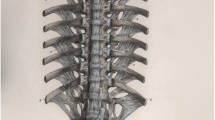Abstract
Background
It is widely believed that the main function of denticulate ligaments (DLs) is to stabilize the spinal cord within the vertebral canal. The aim of this study was to assess the anatomical and histological structure of the DLs and to document any regional differences.
Methods
Five formalin-fixed adult cadavers were used. The DLs were exposed via the posterior approach, and detailed anatomy and histology of these structures were documented.
Results
The main findings were: (1) each DL is composed of a single narrow fibrous strip that extends from the craniovertebral junction to T12, and each also features 18–20 triangular extensions that attach to the dura at their apices; (2) the triangular extensions are smaller and more numerous at the cervical levels, and are larger and less numerous at the thoracic levels; (3) the apices of the extensions attach to the dura via fibrous bands at cervical levels (each band 3-5 mm long) and lower thoracic levels (21-26 mm long), whereas they attach directly to the dura at upper thoracic levels; (4) the narrow fibrous strip of the DL features longitudinally oriented collagen fibers, whereas the triangular extensions are composed of transverse and obliquely oriented collagen fibers. The collagen fibers are thicker and more abundant at the cervical than at the thoracic levels.
Conclusion
DL histology and anatomy are strongly correlated with the function of this structure at different spinal levels. It is important to have accurate knowledge about DLs as these structures are relevant for clinical procedures that involve the spinal cord or craniovertebral junction.







Similar content being viewed by others
References
Batzdorf U, Holly LT (2011) Idiopathic thoracic spinal cord herniation: report of 10 patients and description of surgical approach. J Spinal Disord Tech. PMID:22134729
Bedford PD, Bosanquet FD (1952) Degeneration of the spinal cord associated with cervical spondylosis. Lancet 2:55–59
Benzel EC, Lancon J, Kesterson L, Hadden T (1991) Cervical laminectomy and dentate ligament section for cervical spondylotic myelopathy. J Spinal Disord 4:286–295
Bruneau M, George B (2010) Classification system of foramen magnum meningiomas. J Craniovertebr Junction Spine 1:10–17
Carpenter MB (1991) Core text of neuroanatomy, 3rd edn. Williams & Wilkins, Baltimore, pp 2–3
El-Khoury GY, Whitten CG (1993) Trauma to the upper thoracic spine: anatomy, biomechanics, and unique imaging features. AJR Am J Roentgenol 160:95–102
Williams PL, Warwick R, Dyson M, Bannister LH (1989) Gray's anatomy, 37th edn. Edinburgh, Churchill Livingstone, pp 924–1091
Fabinyi G, Dutton J (1980) The surgical treatment of spasmodic torticollis. ANZ J Surg 50:155–157
Ghostine S, Baron EM, Perri B, Jacobson P, Morsette D, Hsu FPK (2009) Thoracic cord herniation through a dural defect: description of a case and review of the literature. Neurol Sci 71:362–366
Groen RJM, Middel B, Meilof JF, de Vos-van de Biezenbos JBM, Enting RH, Coppes MH, Journee LH (2009) Operative treatment of anterior thoracic spinal cord herniation: three new cases and an individual patient data meta-analysis of 126 case reports. Neurosurgery 64:145–159
Jung TY, Jung S, Kim IY, Kang SS (2009) Foramen magnum meningioma originating from the dentate ligament. Acta Neurochir (Wien) 151:385–388
Levine DN (1997) Pathogenesis of cervical spondylotic myelopathy. J Neurol Neurosurg Psychiatry 62:334–340
Moore KL (1992) Clinically oriented anatomy, 2nd edn. Williams & Wilkins, Baltimore, pp 616–617
Nagata K, Matsui T, Joshita H, Shigeno T, Asano T (1989) Surgical treatment of spasmodic torticollis: effectiveness of microvascular decompression. Brain Nerve 41:97–102
Netter FH, Company CP (1983) The CIBA collection of medical illustrations. Vol. 1 Nervous system, CIBA-GEIGY, pp. 37
Piepgras DG (1977) Posterior decompression for myelopathy due to cervical spondylosis: laminectomy alone versus laminectomy with dentate ligament section. Clin Neurosurg 24:508–515
Rengachary SS, Pelle D, Guthikonda M (2008) Contributions of Johann Jacob Huber to the surface anatomy of the spinal cord and meninges. Neurosurgery 62:1370–1373
Tubbs RS, Mortazavi MM, Loukas M, Shoja MM, Cohen-Gadol AA (2011) The intracranial denticulate ligament: anatomical study with neurosurgical significance. J Neurosurg 114:454–457
Tubbs RS, Salter G, Grabb PA, Oakes WJ (2001) The denticulate ligament: anatomy and functional significance. J Neurosurg 94:271–275
Acknowledgments
This study was not supported by any funding.
Conflicts of interest
None.
Author information
Authors and Affiliations
Corresponding author
Rights and permissions
About this article
Cite this article
Ceylan, D., Tatarlı, N., Abdullaev, T. et al. The denticulate ligament: anatomical properties, functional and clinical significance. Acta Neurochir 154, 1229–1234 (2012). https://doi.org/10.1007/s00701-012-1361-x
Received:
Accepted:
Published:
Issue Date:
DOI: https://doi.org/10.1007/s00701-012-1361-x




